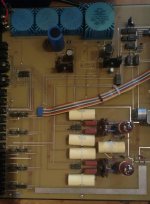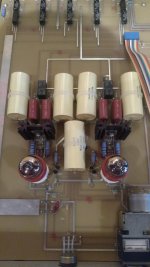Why does my phono preamp have two output coupling capacitors, while my preamplifier has four input coupling capacitors? I hope I said that right, feel free to correct.
The caps are there to block DC offset, and makers of preamps (line & phono) and power amps want to be sure that no DC gets into amp inputs, so caps are provided, since the makers can't know in advance what their products will get connected to. Tube preamps and some SS ones may have a high DC quiescent voltage on their outputs, so the blocking cap is mandatory there. As a result of this precaution, you end up with two caps in series with an amp-preamp connection. I would not worry about it. You could always bypass one cap in either the pre or power amp, but not both.
But why does my tube phono preamp have 2 capacitors, L + R, while my tube preamp has 4 capacitors (I believe on the input side, but I can't really trace them). Maybe 2 are input and 2 are output? Be patient with me.
What preamp, better still do you have a schemtic.
Without more information it's just speculation.
Without more information it's just speculation.
I own a Belles 21A and replaced the 4 coupling capacitors back in 2011 or 2012. These appear to be for the output. This preamp has both balanced output and single ended output. There is one cap for each of the following: L+, L-, R+, and R-. I do not know how the SE outputs are created from the balanced... I do not have a schematic.
I replaced the caps with DynamiCaps (the E version). This made a huge improvement in sound quality. I also got rid of the 4 original bypass capacitors. I don't remember the values I used.
The coupling capacitors and the tubes have an oversized effect on the sonics of this preamp.
Quality control issues aside, this is a great preamp.
I replaced the caps with DynamiCaps (the E version). This made a huge improvement in sound quality. I also got rid of the 4 original bypass capacitors. I don't remember the values I used.
The coupling capacitors and the tubes have an oversized effect on the sonics of this preamp.
Quality control issues aside, this is a great preamp.
Thanks, that helps a lot. But does "got rid of the 4 original bypass capacitors" mean eliminated or replaced?
I think I read somewhere the XLR outputs are not really balanced but actually single ended.
My four couplers are Amphion 2.2uF. I don't know the value of the bypass caps, but I am going to pull the board and figure it out. I think there was an Auricap 15uF upgrade with no bypass caps as well. Does that make sense? 15uF seems excessive.
Does that help you remember the values of the old or new caps you used?
I think I read somewhere the XLR outputs are not really balanced but actually single ended.
My four couplers are Amphion 2.2uF. I don't know the value of the bypass caps, but I am going to pull the board and figure it out. I think there was an Auricap 15uF upgrade with no bypass caps as well. Does that make sense? 15uF seems excessive.
Does that help you remember the values of the old or new caps you used?
Last edited:
The output of the tube will have a huge DC offset on it. The output caps need to be there and need to have a voltage rating higher than the DC level that's there, or better yet higher than the supply voltage. With tubes it's actually quite easy to have a balanced output from a single ended design.
If you aren't seeing any issues with the output of the preamp it's not likely there will be any improvement by drastically changing the size of the output caps. The guys who engineer these things originally usually do the math to get it right in the first place. Those look to be film caps, likely MKP type which don't give much trouble. Be wary of a lot of the "improvements" seen about the internet.
If you aren't seeing any issues with the output of the preamp it's not likely there will be any improvement by drastically changing the size of the output caps. The guys who engineer these things originally usually do the math to get it right in the first place. Those look to be film caps, likely MKP type which don't give much trouble. Be wary of a lot of the "improvements" seen about the internet.
Last edited:
How many outputs does your preamp have?Why does my phono preamp have two output coupling capacitors, while my preamplifier has four input coupling capacitors? I hope I said that right, feel free to correct.
How many inputs?
In general it´s one cap per output or input.
Sometimes when no DC is involved , caps may be unneeded; personally I prefer to use some anyway, if anything to avoid offset problems.
I just read the manual (duh) and it does have a pair of Balanced outputs, which is good, because that is what I use.
The preamplifier has five stereo inputs and two stereo outputs (one balanced and one unbalanced) and four coupling capacitors. My tube phono preamp has two output coupling caps. So that's why I don't understand the math for the number of capacitors.How many outputs does your preamp have?
How many inputs?
In general it´s one cap per output or input.
Sometimes when no DC is involved , caps may be unneeded; personally I prefer to use some anyway, if anything to avoid offset problems.
Last edited:
I bought it new. The original coupling capacitors were 2.2 uF 250v with an unknown value bypass capacitor. The later upgrade version from the OEM was 15uF 200v with no bypass capacitors. I am trying to figure out if I should put in a similar upgrade. The 15uF seems excessive. I am tempted to leave it at 2.2, but then should I remove the bypass caps?The output of the tube will have a huge DC offset on it. The output caps need to be there and need to have a voltage rating higher than the DC level that's there, or better yet higher than the supply voltage. With tubes it's actually quite easy to have a balanced output from a single ended design.
If you aren't seeing any issues with the output of the preamp it's not likely there will be any improvement by drastically changing the size of the output caps. The guys who engineer these things originally usually do the math to get it right in the first place. Those look to be film caps, likely MKP type which don't give much trouble. Be wary of a lot of the "improvements" seen about the internet.
Oh, and the manual does specify it has one pair of balanced outputs.
Last edited:
Those look to be film caps, likely MKP type which don't give much trouble. Be wary of a lot of the "improvements" seen about the internet.
I don't want to get crazy ridiculous. A lot of people say they hear marked improvements with capacitor changes, several on this particular preamp. I think I could spring for a couple of hundred dollars on a new set of four as an experiment without breaking the bank. I need to decide on what value given the two different versions I know of 2.2uF or 15uF. Or maybe some other value.
15ufd is just wrong. Way too big. I can't remember the load resistor value, but i belive it to be 100k.
15ufd would give you an unload frequency response to 0.1Hz. 2.2ufd is about 0.7Hz.
The load resistor is in parallel with the power amp input impedance, so unless your power amp has a really low input impedance, i doubt you need 15ufd.
15ufd would give you an unload frequency response to 0.1Hz. 2.2ufd is about 0.7Hz.
The load resistor is in parallel with the power amp input impedance, so unless your power amp has a really low input impedance, i doubt you need 15ufd.
I used 5uF 310V Dynamicaps without bypasses. And I agree... 15uF is just wrong. 2.2uF should work fine.
If I were to do this project today, I would look for cheaper/better caps. At the same time, this is a really good preamp so I would not be afraid to spend a few extra bucks on it. Coupling capacitor opinions vary wildly...
If I were to do this project today, I would look for cheaper/better caps. At the same time, this is a really good preamp so I would not be afraid to spend a few extra bucks on it. Coupling capacitor opinions vary wildly...
https://www.mouser.com/ProductDetail/WIMA/MKP4F042205I00JB00/?qs=sJjjjplDs9s60hni6vGNiw==
This is my idea of a fancy capacitor. I use these in my filters and tone controls. I'll pay more when I'm convinced I'm getting something for my money.
This is my idea of a fancy capacitor. I use these in my filters and tone controls. I'll pay more when I'm convinced I'm getting something for my money.
I own a Belles 21A and replaced the 4 coupling capacitors back in 2011 or 2012. These appear to be for the output. This preamp has both balanced output and single ended output. There is one cap for each of the following: L+, L-, R+, and R-.
So then back to my original post, if my preamp has four, why does my phono preamp only have two output coupling caps, R+ and L+?
The phono preamp is one pair unbalanced RCA only. So maybe my preamp has a pair of caps for balanced outputs and another pair for the unbalanced outputs?
There are two signal lines plus a ground for each channel of a balanced connection, so it requires four signal lines (and 4 cap) to make up a stereo pair. An RCA connection only has one signal line per channel, plus a ground, so only 2 caps for a stereo pair.
- Home
- Source & Line
- Analog Line Level
- How may coupling caps should there be?

